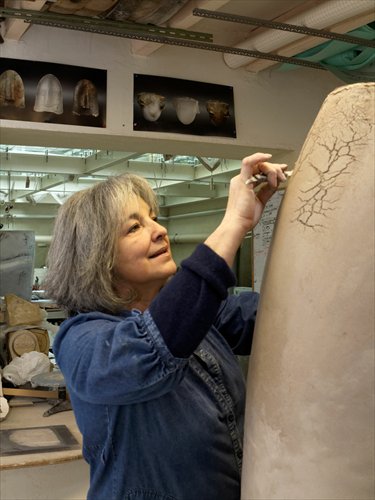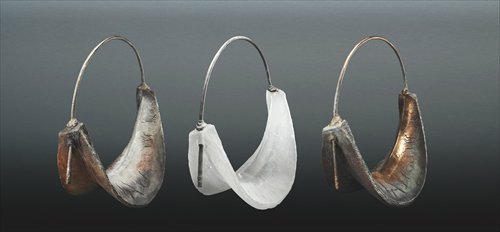Between the cracks
The artistic journey of French ceramicist Christine Fabre
Christine Fabre (pictured below), born in 1951 in Marseille, France, started her career as a ceramicist in 1975. In the beginning, she only produced household ceramics, but after she encountered a piece of China-made porcelain from the 13th century at a French museum, her artistic direction completely changed.

Liuli China Museum in Tianzifang is currently hosting Fabre's first solo exhibition in China, From Visible to Invisible, displaying several signature series by the artist.
The Plat series features thick plates decorated with fading colors at their edges, bringing to mind the ocean and land that constitute the surface of our planet, and emitting a sense of eternity through simple yet classic shapes.
Meanwhile, Sphère is a series of hollow ball-shaped pieces. Most have a large opening at the top, beside which Fabre has added metal elements. For instance, in one piece, the artist pays homage to summertime with a metal lotus leaf, and in another she uses a pair of patches to meditate on the self-repairing capacity of the sphere, which stands for our planet.
Artistic poetry
The exhibition turns to a poetic space for meditation with the combination of Fabre's beautiful works and lines from her favorite writers and philosophers printed on the wall.
Fabre said that she believes French philosopher Gaston Bachelard's claim that the space is not a vessel in which solid matter resides, but rather is a space for human consciousness. Thus for Fabre, her massive plates and containers appear empty, yet they may contain everything.
"We live our entire life in a space of our creation," said Fabre, who is a member of the International Academy of Ceramics, and whose works have been collected by museums in France and Germany and exhibited worldwide.
Fabre's works are often compared to Chinese ceramics made in the Song Dynasty (960-1279) and Japanese raku ware, which is a type of hand-shaped tea ware featuring a porous texture resulting from low firing temperatures.
As a matter of fact, Fabre's career as a ceramic artist was sparked by an encounter with a piece of Song Dynasty porcelain that she came across at the Guimet Museum in Paris more than 30 years ago.
She was thrilled to see the spiderweb of cracks running cross the surface of a long-necked vase, and following that, cracks became a signature pattern in her works.
Despite diversified themes of exhibited works, almost all of them have on their surface, which often is unglazed, some clear traces of cracks. According to a native American legend, when a crack appears in a piece of fired pottery, it will make a sound like life itself. And for Fabre, the cracks on her works are the breath of these objects.

Liuli China Museum is currently hosting Christine Fabre's first solo exhibition in China, displaying several signature series by the artist. Photos: Courtesy of the museum
Departure from Eastern art
Although Fabre got inspiration from Song porcelain, she has advanced a long way along her own path.
She started out with clay, and then introduced other materials such as wood and leather. Some of her works are burned with sawdust after they are removed from the kiln.
She even buries some under ostrich feathers so that she can get the elegant traces of the feathers on the surface of the pieces.
It was after the artist experimented to develop her own way of making ceramics that she realized her technique was very similar to the Japanese raku making.
"If one says I make raku, that says nothing because what counts for me is not the technique we practice but what we create using it," said the artist. "My journey is sincere, and rather solitary."
For Fabre, art is about what forms naturally within; it is what irrigates strength and fills the soul. She absorbs both good and bad news from life, and as a way to counter and respond to the world, she creates objects that serve as her prayers and comfort.
Inspiration from African life
On view at the exhibition are two series of works taking inspiration from African life. The Envol series magnifies the earrings of African women and turns them into large statues made of clay, glass and metal.
The artist feels empathy for the sufferings of women in the world, and through those beautiful butterfly-like earrings she pays homage to the optimism and resilience of females, especially those in Africa.
The Canope series sees the artist remake the Canopic jars of ancient Egypt, which were used to store and preserve the viscera of the dead during the mummification process.
For Fabre, the jars convey a certain dignity and serve as a powerful image for meditating on life and our world.
Chang Yi, co-founder of Liuli China Museum, said that Fabre's works offer an amazing experience as they revive a time-honored art with a powerful and contemporary approach.
"It is an original innovation that does not repeat the past, and nor can it be repeated in the future," said Chang.
Date: Until January 6, 10 am to 5 pm (closed Mondays)
Venue: Liuli China Museum
琉璃艺术博物馆
Address: 25 Taikang Road
泰康路25号
Admission: 20 yuan
Call 6467-2268 for details